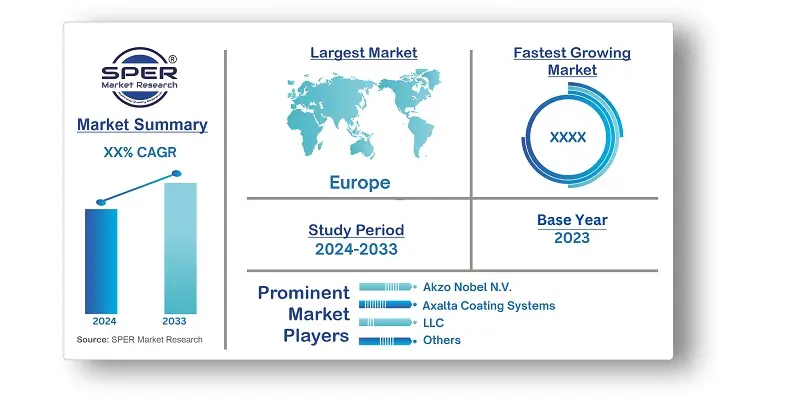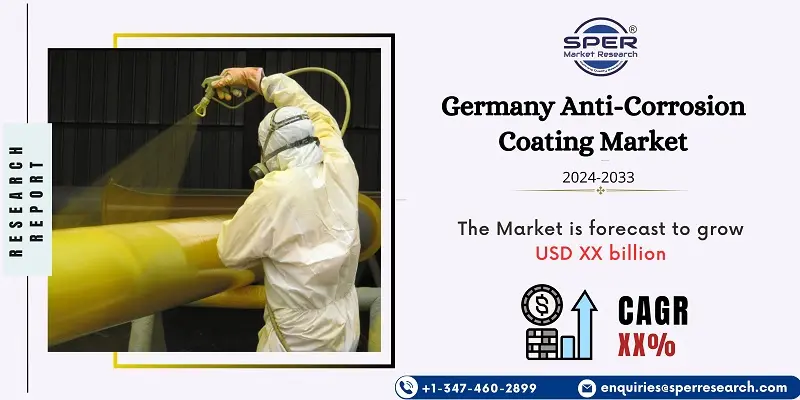
Germany Anti-Corrosion Coating Market Trends, Share, Size, Revenue, Scope and Future Outlook
Germany Anti-Corrosion Coating Market Growth, Size, Trends Analysis- By Resin Type, By Technology, By End User- Regional Outlook, Competitive Strategies and Segment Forecast to 2033
| Published: Oct-2024 | Report ID: CHEM2498 | Pages: 1 - 101 | Formats*: |
| Category : Chemical & Materials | |||
- In June 2022, Hempel introduced a new CUI coating that is well-known for its ability to dry quickly and its ability to prevent corrosion under insulation. This coating protects against corrosion and increases output in facilities that produce energy and oil.

- Infrastructure Industry Demand Is Growing: Both by market share and expected rate of growth, the infrastructure segment leads the other two. The three main components of the infrastructure were roads, bridges, and trains. There will likely be a rise in demand for anti-corrosion coatings due to the population growth and expansion of infrastructure projects.
- Increased investment in infrastructure is driving up demand for anti-corrosion coatings. Anti-corrosion coatings are especially important for applications in infrastructure and global development.
- There are various obstacles facing the German anti-corrosion coating market. First, the formulation and production of coatings are impacted by strict environmental restrictions addressing volatile organic compounds (VOCs) and hazardous ingredients. This forces producers to develop with eco-friendly alternatives. Furthermore, major investments in research and development are required to meet the growing demand for high-performance coatings, which might be prohibitive for smaller businesses.
- Low-cost import competition is another issue that local producers must deal with since it can threaten their superior quality. Additionally, the market is plagued by volatile raw material prices, which have an impact on pricing strategies and manufacturing costs.

| Report Metric | Details |
| Market size available for years | 2020-2033 |
| Base year considered | 2023 |
| Forecast period | 2024-2033 |
| Segments covered | By Resin Type, By Technology, By End User |
| Regions covered | Eastern Region, Western Region, Northern Region, Southern Region |
| Companies Covered | Akzo Nobel N.V., Axalta Coating Systems, LLC, BASF SE, H.B. Fuller Company, Hempel A/S, Jotun, PPG Industries, Inc., RPM International Inc., and others. |
- Construction Industry
- Automotive Sector
- Marine Industry
- Oil and Gas Industry
- Manufacturing and Heavy Machinery
- Aerospace Sector
- Infrastructure and Utilities
- Transportation and Logistics
- Industrial Equipment
- Agricultural Equipment
| By Resin Type: | |
| By Technology: | |
| By End User: |
- Germany Anti-Corrosion Coating Market Size (FY’2024-FY’2033)
- Overview of Germany Anti-Corrosion Coating Market
- Segmentation of Germany Anti-Corrosion Coating Market By Resin Type (Epoxy, Alkyds, Polyester, Vinyl Ester, Others)
- Segmentation of Germany Anti-Corrosion Coating Market By Technology (Water-borne, Solvent-borne, Powder, UV-cured)
- Segmentation of Germany Anti-Corrosion Coating Market By End User (Oil and Gas, Marine, Power, Infrastructure, Industrial, Aerospace and Defence, Transportation)
- Expansion Analysis of Germany Anti-Corrosion Coating Market
- Problems and Obstacles in Germany Anti-Corrosion Coating Market
- Competitive Landscape in the Germany Anti-Corrosion Coating Market
- Impact of COVID-19 and Demonetization on Germany Anti-Corrosion Coating Market
- Details on Current Investment in Germany Anti-Corrosion Coating Market
- Competitive Analysis of Germany Anti-Corrosion Coating Market
- Prominent Players in the Germany Anti-Corrosion Coating Market
- SWOT Analysis of Germany Anti-Corrosion Coating Market
- Germany Anti-Corrosion Coating Market Future Outlook and Projections (FY’2024-FY’2033)
- Recommendations from Analyst
1.1. Scope of the report1.2. Market segment analysis
2.1. Research data source
2.1.1. Secondary Data2.1.2. Primary Data2.1.3. SPER’s internal database2.1.4. Premium insight from KOL’s
2.2. Market size estimation
2.2.1. Top-down and Bottom-up approach
2.3. Data triangulation
4.1. Driver, Restraint, Opportunity and Challenges analysis
4.1.1. Drivers4.1.2. Restraints4.1.3. Opportunities4.1.4. Challenges
4.2. COVID-19 Impacts of the Germany Anti-Corrosion Coating Market
5.1. SWOT Analysis
5.1.1. Strengths5.1.2. Weaknesses5.1.3. Opportunities5.1.4. Threats
5.2. PESTEL Analysis
5.2.1. Political Landscape5.2.2. Economic Landscape5.2.3. Social Landscape5.2.4. Technological Landscape5.2.5. Environmental Landscape5.2.6. Legal Landscape
5.3. PORTER’s Five Forces
5.3.1. Bargaining power of suppliers5.3.2. Bargaining power of buyers5.3.3. Threat of Substitute5.3.4. Threat of new entrant5.3.5. Competitive rivalry
5.4. Heat Map Analysis
6.1. Germany Anti-Corrosion Coating Market Manufacturing Base Distribution, Sales Area, Product Type6.2. Mergers & Acquisitions, Partnerships, Product Launch, and Collaboration in Germany Anti-Corrosion Coating Market
7.1. Germany Anti-Corrosion Coating Market Size, Share and Forecast, By Resin Type, 2020-20267.2. Germany Anti-Corrosion Coating Market Size, Share and Forecast, By Resin Type, 2027-20337.3. Epoxy7.4. Alkyds7.5. Polyester7.6. Vinyl Ester7.7. Others
8.1. Germany Anti-Corrosion Coating Market Size, Share and Forecast, By Technology, 2020-20268.2. Germany Anti-Corrosion Coating Market Size, Share and Forecast, By Technology, 2027-20338.3. Water-borne8.4. Solvent-borne8.5. Powder8.6. UV-cured
9.1. Germany Anti-Corrosion Coating Market Size, Share and Forecast, By End User, 2020-20269.2. Germany Anti-Corrosion Coating Market Size, Share and Forecast, By End User, 2027-20339.3. Oil and Gas9.4. Marine9.5. Power9.6. Infrastructure9.7. Industrial9.8. Aerospace and Defence9.9. Transportation
10.1. Germany Anti-Corrosion Coating Market Size and Market Share
11.1. Germany Anti-Corrosion Coating Market Size and Market Share By Region (2020-2026)11.2. Germany Anti-Corrosion Coating Market Size and Market Share By Region (2027-2033)11.3. Eastern Region11.4. Western Region11.5. Northern Region11.6. Southern Region
12.1. Akzo Nobel N.V.
12.1.1. Company details12.1.2. Financial outlook12.1.3. Product summary12.1.4. Recent developments
12.2. Axalta Coating Systems, LLC
12.2.1. Company details12.2.2. Financial outlook12.2.3. Product summary12.2.4. Recent developments
12.3. BASF SE
12.3.1. Company details12.3.2. Financial outlook12.3.3. Product summary12.3.4. Recent developments
12.4. H.B. Fuller Company
12.4.1. Company details12.4.2. Financial outlook12.4.3. Product summary12.4.4. Recent developments
12.5. Hempel A/S
12.5.1. Company details12.5.2. Financial outlook12.5.3. Product summary12.5.4. Recent developments
12.6. Jotun
12.6.1. Company details12.6.2. Financial outlook12.6.3. Product summary12.6.4. Recent developments
12.7. PPG Industries, Inc.
12.7.1. Company details12.7.2. Financial outlook12.7.3. Product summary12.7.4. Recent developments
12.8. RPM International Inc.
12.8.1. Company details12.8.2. Financial outlook12.8.3. Product summary12.8.4. Recent developments
12.9. Others
SPER Market Research’s methodology uses great emphasis on primary research to ensure that the market intelligence insights are up to date, reliable and accurate. Primary interviews are done with players involved in each phase of a supply chain to analyze the market forecasting. The secondary research method is used to help you fully understand how the future markets and the spending patterns look likes.
The report is based on in-depth qualitative and quantitative analysis of the Product Market. The quantitative analysis involves the application of various projection and sampling techniques. The qualitative analysis involves primary interviews, surveys, and vendor briefings. The data gathered as a result of these processes are validated through experts opinion. Our research methodology entails an ideal mixture of primary and secondary initiatives.



Frequently Asked Questions About This Report
PLACE AN ORDER
Year End Discount
Sample Report
Pre-Purchase Inquiry
NEED CUSTOMIZATION?
Request CustomizationCALL OR EMAIL US
100% Secure Payment






Related Reports
Our Global Clients
Our data-driven insights have influenced the strategy of 200+ reputed companies across the globe.






















